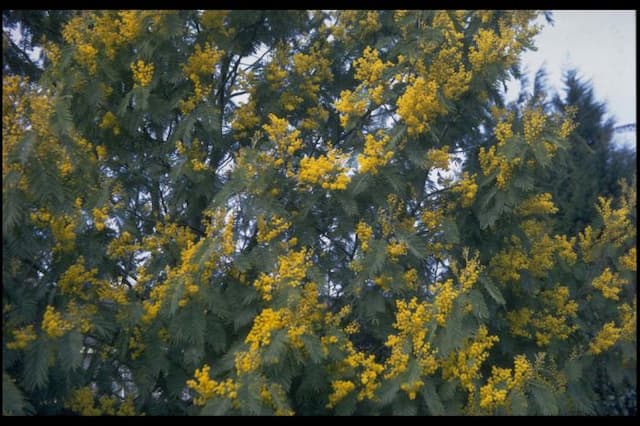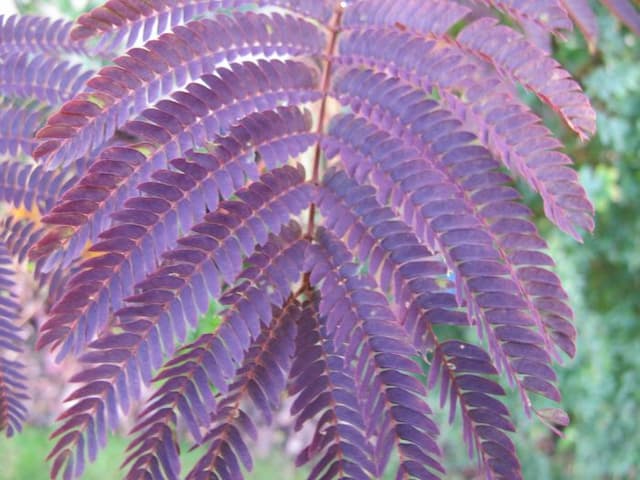Silver Wattle Acacia dealbata 'Gaulois Astier'

ABOUT
The Acacia dealbata 'Gaulois Astier', often referred to as Silver Wattle, is a visually striking plant with unique characteristics that make it a favorite in gardens and landscapes. It boasts feathery, fern-like foliage that is a silvery-green color, providing a soft textured appearance. The leaves are bipinnate, which means they are arranged on each side of the stem in pairs, each with numerous small leaflets that give the Silver Wattle its delicate, lacy look. During the blooming period, which typically occurs in winter to early spring, Silver Wattle is adorned with an abundance of small, fluffy, bright yellow flowers. These flowers grow in showy clusters or spherical pom-poms and are known for their intense, sweet fragrance, which can fill the air and attract a range of pollinators, including bees and butterflies. After the flowering period, the plant may produce seed pods, which are elongated and may have a slight curve. The bark of the Silver Wattle is smooth and can vary in color from gray to a greenish hue. Over time, the bark may become rougher and develop a more textured appearance. The plant has a graceful, spreading habit, often forming a rounded or umbrella-like canopy that is attractive throughout the year, even when not in flower due to its foliage and structural form. The overall appearance of the Silver Wattle is one of elegance and brightness, which, combined with its fragrant blooms and attractive foliage, makes it a popular choice for adding a touch of silver and yellow to the landscape. Because of its lush foliage, it can also be used as a screen or windbreak in suitable climates.
About this plant
 Names
NamesSynonyms
Silver Wattle, Blue Wattle, Mimosa.
Common names
Acacia decurrens var. dealbata, Racosperma dealbatum
 Toxicity
ToxicityTo humans
Mimosa, a common name for Acacia dealbata 'Gaulois Astier', has parts that can be toxic if ingested. The bark, leaves, and seeds contain compounds that may cause gastrointestinal distress such as nausea, vomiting, and diarrhea if consumed in significant quantities. It is recommended to avoid ingesting any part of the plant and to wash hands after handling it to prevent irritation.
To pets
Mimosa, the common name for Acacia dealbata 'Gaulois Astier', can be toxic to pets if consumed. As with humans, the bark, leaves, and seeds contain components that can irritate an animal's digestive system, leading to symptoms like vomiting, diarrhea, and abdominal pain. Pets should not be allowed to ingest any part of the plant, and pet owners should be vigilant when pets are in the vicinity of the mimosa to prevent poisoning.
 Characteristics
CharacteristicsLife cycle
Perennials
Foliage type
Evergreen
Color of leaves
Blue-green
Flower color
Yellow
Height
20-30 feet (6-9 meters)
Spread
15-20 feet (4.5-6 meters)
Plant type
Tree
Hardiness zones
8
Native area
Australia
Benefits
 General Benefits
General Benefits- Ornamental appeal: Acacia dealbata 'Gaulois Astier', commonly known as Silver Wattle, has attractive silvery-blue foliage and bright yellow, fragrant flowers that enhance the aesthetic of gardens and landscapes.
- Habitat support: Silver Wattle provides a habitat for birds and insects, creating a biodiverse environment.
- Erosion control: Its extensive root system can help stabilize soil and control erosion on slopes and banks.
- Windbreak: With its bushy growth, Silver Wattle can act as a windbreak, protecting other plants and reducing wind erosion.
- Shade provider: The canopy of the Silver Wattle can offer shade for underplanting or recreational areas during sunny days.
- Nitrogen fixation: As a legume, it has the ability to fix atmospheric nitrogen through its root nodules, thereby improving soil fertility.
 Medical Properties
Medical Properties- Antimicrobial: Acacia dealbata, commonly known as Silver Wattle, has been reported to possess antimicrobial properties due to the presence of bioactive compounds in its extracts, which may inhibit the growth of certain bacteria and fungi.
- Anti-inflammatory: The plant's extracts have been traditionally used to reduce inflammation, although scientific evidence for this use may not be well-documented.
- Analgesic: There is anecdotal evidence suggesting that Acacia dealbata may have pain-relieving properties, but this use lacks robust scientific validation.
- Antioxidant: Compounds found in the plant might exhibit antioxidant effects, which can be beneficial in neutralizing harmful free radicals in the body.
 Air-purifying Qualities
Air-purifying QualitiesThis plant is not specifically known for air purifying qualities.
 Other Uses
Other Uses- Natural Dye: The leaves and flowers of the Mimosa tree can be used to produce a range of dyes for fabrics, from soft yellows to green hues.
- Tannin Source: Mimosa bark is high in tannins and can be used in the tanning process to convert animal hides into leather.
- Insecticide: Some components of the Mimosa can act as natural insect repellents or insecticides when applied to other plants or used in enclosed spaces.
- Floral Arrangements: Mimosa flowers are fragrant and visually appealing, making them excellent for use in fresh or dried floral arrangements.
- Sheet Mulching Material: Leaves of the Mimosa can be used in sheet mulching practices to suppress weeds and add organic matter to the soil.
- Erosion Control: The extensive root system of the Mimosa can help stabilize soil and control erosion on banks and slopes.
- Photographic Dye: Extracts from the Mimosa can be used as a dye in certain types of analogue photography processing techniques.
- Natural Fertilizer: The fallen leaves of the Mimosa, which are rich in nitrogen and other minerals, can be composted and used as a fertilizer.
- Perfumery: The scent of Mimosa flowers is sometimes extracted and used in the formulation of perfumes and fragrant oils.
- Soil Improvement: The Mimosa is capable of fixing atmospheric nitrogen, thus improving soil quality over time where it's planted.
Interesting Facts
 Feng Shui
Feng ShuiThe Mimosa is not used in Feng Shui practice.
 Zodiac Sign Compitability
Zodiac Sign CompitabilityThe Mimosa is not used in astrology practice.
 Plant Symbolism
Plant Symbolism- Renewal: The Acacia dealbata, commonly known as the Silver Wattle, often flowers at the end of winter, signaling the onset of spring and the renewal of life.
- Purity: With its bright yellow blossoms, the Silver Wattle is often associated with purity and the cleansing of negative energies.
- Friendship: The tree's hardy and resilient nature signifies enduring friendships that can withstand adversity.
- Secret Love: In the Victorian language of flowers, the Acacia dealbata can represent a secret love or an admiration from afar.
- Resilience: As a hardy plant that can thrive in challenging conditions, the Silver Wattle often symbolizes resilience and the ability to persevere.
 Water
WaterThe Mimosa Tree, commonly known for Acacia dealbata 'Gaulois Astier', prefers to be watered deeply but infrequently to mimic its natural habitat conditions. Generally, during the growing season in spring and summer, watering once a week with approximately 1 to 2 gallons of water would suffice for an established tree, depending on the soil and climate conditions. In the cooler months, you can reduce watering to once every two to three weeks, making sure the soil is dry to the touch between waterings. Young plants may require more frequent watering, every few days, until they are established. Be cautious of over-watering, which can lead to root rot; ensure proper drainage is in place.
 Light
LightThe Mimosa Tree thrives best in full sun conditions, meaning it should receive at least 6 to 8 hours of direct sunlight daily. Ideal placement would be in a spot that is unobstructed by taller plants or buildings to ensure it gets ample light. If grown indoors, it should be placed near a south-facing window to maximize the light exposure.
 Temperature
TemperatureThe Mimosa Tree can tolerate a wide range of temperatures, but ideal growing conditions are between 60°F and 75°F. It's hardy to about 20°F but should be protected from sustained freezing temperatures, which can damage or kill the plant. Generally, the Mimosa Tree can survive up to zone 8 with proper winter protection.
 Pruning
PruningPrune the Mimosa Tree to maintain its shape and remove any dead or diseased wood. This helps to encourage healthy growth and improve air circulation. Pruning is best done in late winter or early spring before new growth begins, but after the threat of frost has passed. Pruning can be done annually, focusing on thinning out crowded branches and shaping the canopy.
 Cleaning
CleaningAs needed
 Soil
SoilMimosa, commonly known as Silver Wattle, thrives in well-draining, fertile soil with a slightly acidic to neutral pH between 6.0 to 7.0. A mix of garden soil, sand, and compost or aged manure will provide a healthy growing medium. Ensure adequate drainage by adding perlite or pumice to prevent waterlogging.
 Repotting
RepottingSilver Wattle needs repotting every 2-3 years. Younger plants require more frequent repotting due to rapid growth, while mature plants can be repotted less often. It's best to repot in spring before the growing season begins.
 Humidity & Misting
Humidity & MistingSilver Wattle does well in moderate to high humidity levels but is quite adaptable and can tolerate low humidity environments typical in most homes. No specific humidity range is crucial, but aim for above 30% if possible to promote lush foliage.
 Suitable locations
Suitable locationsIndoor
Place Silver Wattle in a bright location with some direct light.
Outdoor
Plant in a sunny spot; protect from frost and water moderately.
Hardiness zone
8-11 USDA
 Life cycle
Life cycleMimosa's life begins with seed germination, which usually requires scarification or heat treatment to break through the hard seed coat. After sprouting, the seedling grows rapidly under favorable conditions of sunlight and moisture, developing a deep root system. As the plant matures, it forms a woody stem and a bipinnate leaf structure characteristic of Acacia species. Mimosa reaches the flowering stage within a few years, producing fragrant yellow flowers in fluffy inflorescences which are pollinated by insects. Following pollination, seed pods develop and mature, eventually releasing seeds to begin a new generation. The plant can also propagate vegetatively through root suckers, contributing to its potential invasiveness in some regions.
 Propogation
PropogationPropogation time
Spring-Early Summer
The most popular method of propagating Acacia dealbata, commonly known as Silver Wattle, is through seed. The best time for sowing the seeds is typically in spring, after the last frost has passed. To enhance germination, seeds of the Silver Wattle should undergo pretreatment, which often includes scarification. This process involves nicking or sanding the seed coat to allow water to penetrate. After scarification, seeds are usually soaked in warm water for about 24 hours to further soften the tough outer shell. They are then sown in well-draining soil at a shallow depth, and kept moist until germination, which may take a few weeks. Seedlings can then be potted on and eventually planted out into their permanent positions when they are large enough to handle and after the threat of frost has passed.









